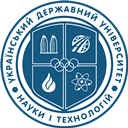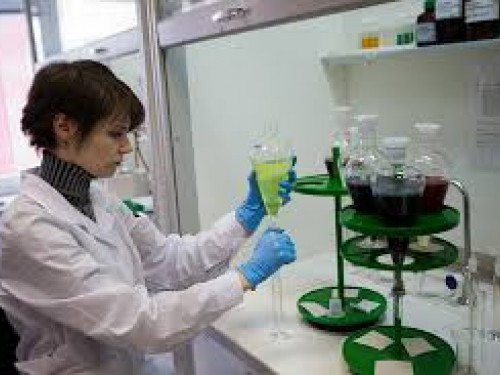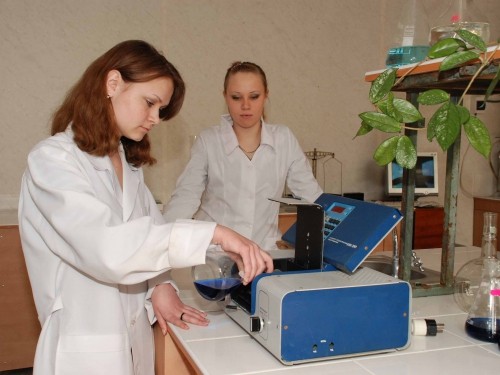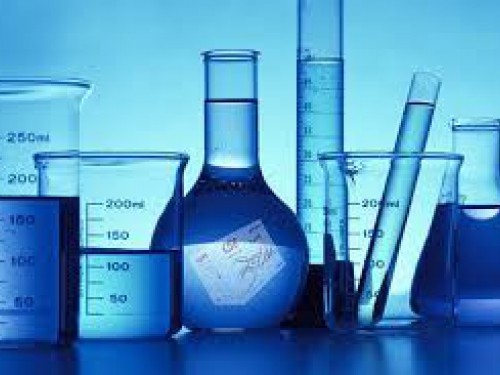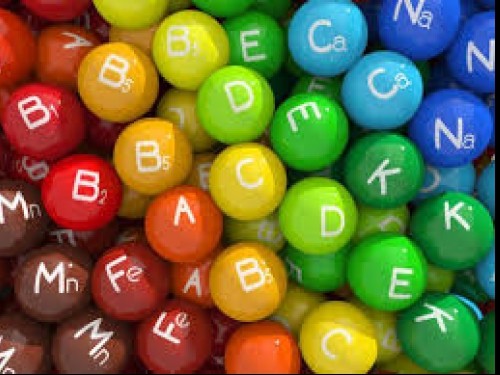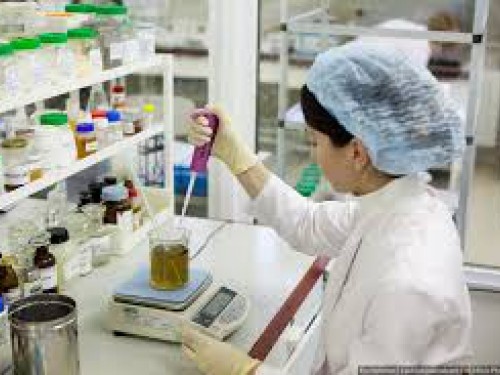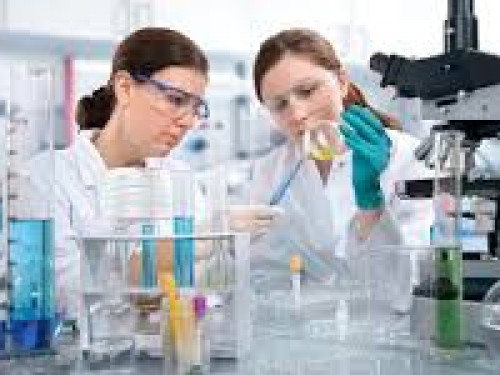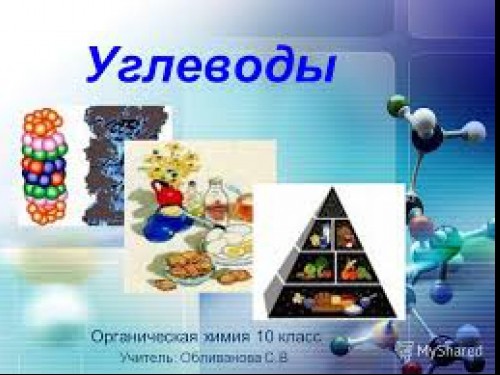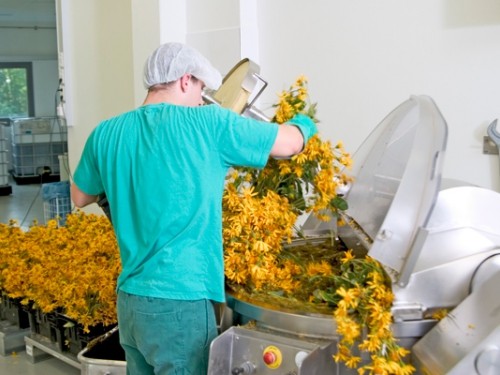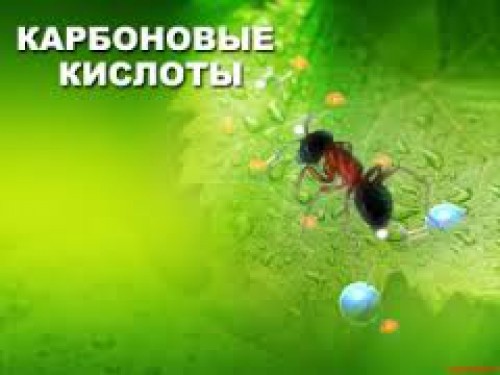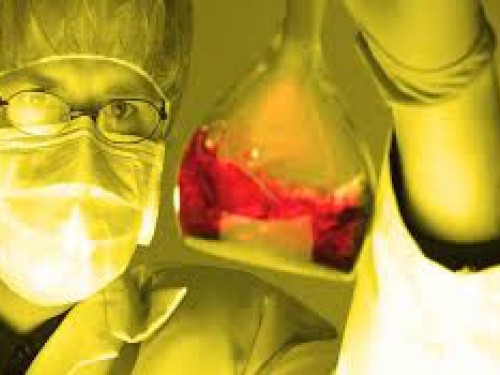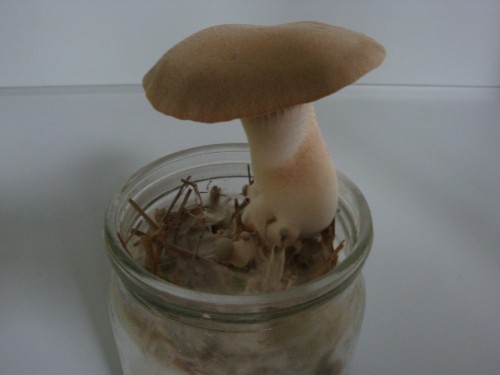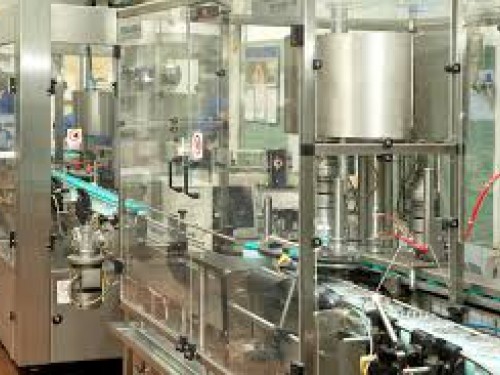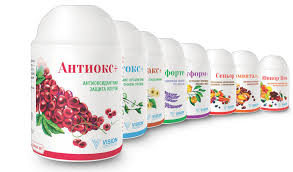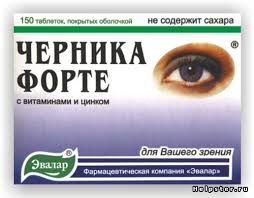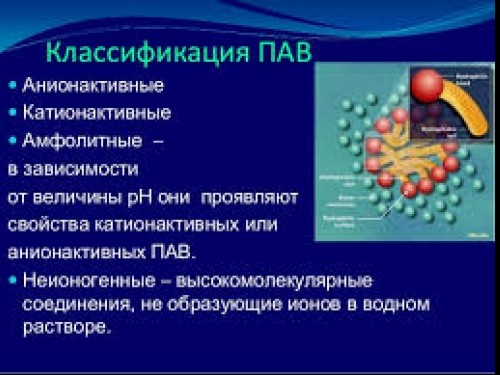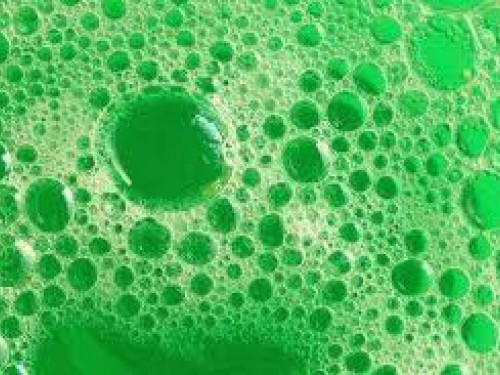DEPARTMENT OF ANALYTICAL CHEMISTRY AND CHEMICAL TECHNOLOGY OF FOOD ADDITIVES AND COSMETICS
EDUCATIONAL DISCIPLINES OF THE DEPARTMENT
- Analytical chemistry
- Instrumental methods of chemical analysis
- Chemistry and technology of nutritional supplements
- Chemistry and technology of cosmetics
- Organic chemistry of natural compounds
- Toxicological chemistry
- Theoretical foundations of the technology of nutritional supplements and cosmetic products
- Chemical and physico-chemical methods of analysis of nutritional supplements and cosmetic products
- Equipment for the food additives and cosmetics production
- Biologically active additives
- Chemistry of surfactants in the food and cosmetics industry
- Fundamentals of Chemical Production Design
- Mathematical modeling and optimization of objects of chemical technology
- Basics of the scientific research
- Intellectual Property
- New Chemical Systems and Technologies in Industry
- Methods of research of chemical-technological systems and processes
- Computer technologies in scientific and engineering activities in technologies of nutritional supplements and cosmetics
- Technology, equipment and design of chemical and cosmetic industries
- Food Production Technologies
Analytical chemistry is a science of methods for the identification and determination of relative quantities of one or more components in a sample of the test substance. The process of identifying substances is called qualitative analysis, determining the quantitative composition of the substance is the subject of quantitative analysis. Analytical chemistry has an important scientific and practical significance. Almost all of the basic chemical laws have been discovered using analytical chemistry methods. The discovery of a number of elements of the periodic system, the definition of the composition of various materials and products became possible due to the application of precise methods of analytical chemistry.
No modern chemical research, whether it is the synthesis of new materials, development of new technological schemes, intensification of production or improve the quality of products can not do without the use of methods of analytical chemistry. There is no such industry in which the control of raw materials and end products would not be used in one way or another.
Note that modern analytical chemistry is characterized by many changes: expanding arsenal of methods of analysis, mathematization introduced automation and analysis tools developed and activities of local, remote and continuous analysis, new opportunities to increase the sensitivity, accuracy and analysis ekspresnosti constantly expanding circle investigated objects. Widely used computers, lasers, appeared laboratory work, significantly increased the role of analytical control, especially environmental objects. Undoubtedly, the basis of new achievements is the accumulated knowledge, experience and theoretical work of many analyst chemists. The future engineer-chemist-technologist of any specialization must well master the foundations of the most common instrumental methods of analysis. Fundamental knowledge and practical skills will enable future professionals to quickly adapt to changes in the proceedings of the latest analysis techniques in modern industries and research laboratories.
Currently, the department studies chemical methods and instrumental analysis that are most common and have the greatest practical importance, namely titrimetric methods, direct potentiometry, potentsiometrychnoe titration, spectrophotometry, Photocolorimetry, polarography and ampermetrychne titration. The basics of chromatographic analysis are also studied, which is the most versatile among methods of separation and determination of mixtures.
The purpose of the discipline is to provide students with knowledge on such issues as the classification of the main types of nutritional supplements, the natural sources of their extraction, the possibility of obtaining their analogues by synthetic or microbiological methods, the dependence of the physico-chemical and biological properties of nutritional supplements on the structure of their molecules, as well as the main paths the practical application of nutritional supplements.
Nutritional supplements are natural, identical natural or artificially synthesized substances that are added to food as an ingredient for technological reasons: extend the shelf life (preservatives), turn food into a color, taste (to preserve and enhance taste), texture, consistence, external look like Usually, nutritional supplements do not include substances that increase the nutritional value of food: vitamins, trace elements, amino acids. Some supplements have been used for centuries, for example, to preserve food – vinegar, salt, or the use of sulfur dioxide in some wines. With the advent of processed foods in the second half of the 20th century, many other additives, both natural and artificial, were introduced. As of 2010, more than 2,800 names of food additives are known. The widespread use of nutritional supplements required the development of their classification, the development of application technology and hygienic regulation.
In the European Union, for the regulation of these additives, as well as to inform consumers, each additive after the approval is assigned a unique number – the E-number. This numbering scheme is adopted and issued by the International Codex Alimentarius Commission for the most common food additives in Europe. In Ukraine, the list of food additives authorized in food products was regulated by September 20, 2015, by the CMU from January 4, 1999, No. 12 “On Approval of the List of Food Supplements Permitted for Use in Food Products”.
Chemistry of cosmetics (or cosmetic chemistry) is a science of the structure and properties of substances used in cosmetics, on how to get cosmetic products and about the effects of these agents on the skin, hair and nails of a person. It is clear that the technology of cosmetic products include knowledge about the methods and methods of industrial effervescence of cosmetic lotions.
To date, the main cosmetic products are:
- Cosmetic solutions (lotions, perfumery products);
- Creams (nutritious, moisturizing and protective creams for face and body, milk, oils, anti-sunblock, for sunburn and after it);
- Means for peeling (masks, scrubs);
- Deodorant (deodorants, antiperspirants);
- Means of decorative cosmetics (powder, lipsticks, tonic creams, carcasses, pencils, lipstick);
- Means for changing the color of hair (paints, luminaries, shades);
- Cosmetic nail care products (varnishes, enamels, varnish removing fluids);
- Hair care products (shampoos, balms, masks, rinses);
- Flaming agents (cosmetic soaps, foams for baths, shower gels);
- Oral care products (toothpastes, powders, elixirs).
The American Consumers Association has estimated that we use an average of about 10 cosmetics daily that contain more than 100 chemical components. Now more and more consumers are asking questions: what percentage of chemistry is in my cosmetics? How safe is the cosmetics to my body? Does it make any harm not only to me but also to the environment?
The discipline “Chemistry and Technology of Cosmetic Products” is constantly evolving along with the development of the cosmetics market and the development of new ingredients. The ability to read labels on a cosmetic label will help you determine if this product is needed, whether the harmful ingredients contained in its contents are not present and whether the “mega-effect” that the manufacturer has promised will be used when using such a tool.
Purpose of the discipline: to teach students to develop the prescription composition of cosmetic products according to their form and purpose; to perform the analysis of the quality of cosmetic products according to the main indicators of normative documentation; to carry out the organoleptic determination of qualitative indicators of different groups of cosmetic products; to carry out quantitative determination of the basic active components of cosmetic means by means of chemical and physico-chemical methods of analysis.
Organic chemistry of natural compounds – a section of organic chemistry that studies chemical compounds that are part of living organisms, the natural ways of their transformation and methods of artificial receipt. As a science, the chemistry of natural compounds arose simultaneously with organic chemistry. The need to allocate an independent discipline, to separate it from classical organic chemistry, arose after the accumulation of a large amount of data, the allocation and study of the structure and properties of chemicals found in living organisms.
Classical organic chemistry examines the properties of compounds belonging to certain classes, often defined as chemistry of hydrocarbons and their derivatives. Natural organic matter is characterized by a large variety of molecular structures, and most of them carry several functional groups and have a complex structure of the carbon skeleton. Therefore, the chemistry of natural compounds is characterized as the chemistry of polyfunctional compounds. The same can be said about chemical reactions. Organic chemistry most often deals with reactions that affect one reaction center in a molecule or one chemical bond. In reactions occurring in a living organism, several reaction centers simultaneously participate and several chemical bonds can be formed or broken in one step. Reactions of biosynthesis differ from reactions of laboratory or industrial organic synthesis also with high selectivity.
The theoretical apparatus of the chemistry of natural compounds completely coincides with the concepts of theoretical organic chemistry. The results obtained in the study of natural compounds, in turn, enrich the theory of organic chemistry, stimulate its development. Isolation from natural materials of biologically active substances, which can be of considerable practical value, initiates the improvement of the methodology of classical organic analysis. Experimental methods of chemistry of natural compounds are different from the classical ones. This is due to the fact that many natural substances are sensitive to a slight increase in temperature, known substances that have a short lifetime, even at room temperature. In addition, substances can be contained in biomaterials in small amounts, sometimes it is a thousandths of a percent or less. Therefore, it is necessary to process large masses of raw materials, and the isolated pure substances have to be studied, using special methods for working with micro-varieties. The difficulty is the separation of complex mixtures, which are usually obtained in the first stage of processing of raw materials.
In the end of the study of the discipline “Organic Chemistry of Natural Compounds,” students will receive knowledge about methods for qualitative and quantitative determination of natural compounds in vegetable raw materials, conditions for sampling and basic stages of sample preparation for the analysis of natural objects, the basic classes and properties of natural compounds.
Toxicological chemistry is a science that studies methods for the allocation of toxic substances from a variety of objects, as well as methods for detecting and quantifying these substances. Its name comes from two Greek words: toxikon – poison and logus – the doctrine, that is science, which studies the properties of poisonous substances and pathological changes in the body, caused by them. Toxicology also studies effective treatments and prevention of poisoning.
The history of the occurrence of toxicological chemistry is rooted in the system of forensic medical toxicology, which studies intentional, random and other poisoning. With the development of the chemical and pharmaceutical industries, the number of pharmaceuticals and substances used in medicine and various branches of the national economy has increased. Many of these substances were toxic. Under certain conditions, these substances can be the cause of poisoning. Some chemicals produced by the chemical industry can pollute the environment and cause poisoning. The source of poisoning can also be the waste water of industrial enterprises that pollute water bodies, which water is used by the population. Liquids used in technology and everyday life, if they are misused, can also be the cause of poisoning.
The amount of toxic substances significantly increases due to the wide use of pesticides (pesticides) to control pests of agricultural crops. Some pesticides treated with plants accumulate in vegetables, fruits and other products of vegetable origin, which are used by the population for nutrition. Separate pesticides accumulate in milk and tissues of animals fed by plants treated with these substances. Pesticides, which are washed away from the surface of plants with rainwater, can fall into the soil, and then in a reservoir, which water is used by the population, and cause poisoning. Of the 400 pesticides used in the world, 262 are of varying degrees mutagenicity. About 7 infectious diseases from 50 well-known people are spreading through food, water, soil and soil in Ukraine and European countries. Because of the operation of nuclear power plants located in Ukraine, about one-third of the territory of our country is contaminated with radionuclides. From radiation, destruction is not only human organisms, but also the genetic code of a person. On average, 45% of toxic substances enter the human body with food and 30% – with potable water.
Consequently, in connection with chemistry, traditional objects of forensic toxicological analysis were supplemented with new objects, which include household items, pesticides, technical fluids, food supplements, cosmetics, etc. Therefore, with the increase of research objects and the nomenclature of investigated compounds, judicial chemistry received the name of toxicological chemistry. This term is the most complete and best reflects the overall content of the subject.
Toxicological chemistry has a prophylactic direction. Conclusions chemists-toxicologists, hygienists, pharmacologists and specialists of other branches of science on the high toxicity of certain pharmaceuticals and substances used in the national economy, is the basis for asking the appropriate authorities to remove these substances from the use or change the conditions of storage and order of release their population. The results of chemical and toxicological and sanitary-hygienic researches of air and sewage of industrial enterprises containing toxic substances are used by sanitary organs to violate the petition to the relevant authorities on the need for the construction or reconstruction of treatment facilities. Using the methods of toxicological chemistry, establish and control the maximum permissible concentrations (MPC) of poisonous substances in water and air. These methods are also used for the valuation of residual quantities of pesticides, heavy metals and some other toxic substances in foodstuffs, etc.
The purpose of teaching the discipline “Toxicological chemistry” is the training of engineers-technologists for production and technological activities, which involves knowledge of the current state, perspectives and main directions of the development of the chemical, food and cosmetic industry; the formation of students theoretical and practical knowledge of the basic methods of analytical control of modern production toxicological indicators. The main tasks of studying the discipline “Toxicological Chemistry” is the mastery of knowledge about the methods of isolation, detection and identification of toxic substances, the system of modern quality control of production and finished products according to toxicological indicators.
The project is a set of developed documents, which gives a legal right to finance all works related to the creation of new or reconstruction of existing facilities with a high technical, economic and environmental indicators, and allows you to complete all assembly-construction, testing and commissioning works. The project is also one of the most important parts of scientific and technological progress, linking science, modern technology and production technology.
For capital construction and technical re-equipment of enterprises appointed design and estimate documentation, which represents the sum of text and graphic materials that describe the future enterprise as a whole and its components in particular. Figuratively speaking, the creation of an enterprise in kind preceded by its “construction on paper”.
The purpose of teaching the discipline “Fundamentals of Chemical Production Design” is the preparation of a bachelor’s degree in industrial and technological activities, which involves knowledge of the current state, prospects and main directions of the development of the chemical industry; formation of theoretical and practical knowledge of the basic principles of the organization and technological design of the enterprises of the industry.
The main tasks of studying the discipline “Fundamentals of Chemical Engineering Design” are the acquisition of knowledge about modern methods of designing chemical production. According to the requirements of the educational-professional program, students must know the main problems of scientific and technological development of the chemical industry, the tasks and directions in designing the production, the system and tasks of design organizations; bases of organizational design of the enterprise; methods, methods and stages of production design; concept, definition, terms of a unified system of design documentation; composition of technical and techno-project; the main stages of the development of the technological scheme of production; principles of compilation of material and thermal balance, block diagrams of physical and chemical processes; methods and methods of mechanization and automation of production; concept of production capacity and its relation with the enterprise being projected; hardware design of the technological process; methods and principles of layout of the main and auxiliary equipment of production, etc.
The purpose of teaching the discipline is to prepare the bachelor for production and technological activities, which involves knowledge of the current state, prospects and the main directions of development of the equipment of the food and cosmetics industry; formation of students theoretical and practical knowledge in design, calculations and practical application of the main types of equipment. To achieve the goal, the student must master knowledge of the design, technological calculations, the principle of the modern equipment for the production of food additives and cosmetics.
According to the requirements of the educational-professional program students must know: the main problems of scientific and technological development of the food and cosmetics industry, the main directions of progress in mechanical engineering; concept, definition, terms of food and cosmetic technology, processes of obtaining a product, influence of technology on the design of apparatus; laws, theories, rules, principles, formulas: the law of conservation of mass and energy, the principle of active force, the principle of optimization of the process, algorithms of material calculations; the classification of the main and auxiliary technological equipment. special equipment; characterization of physico-chemical bases of mixing, crushing, diffusion, extraction, sorption, separation of mixtures; schemes, arrangement, technical characteristics, structure and principle of operation of pumps, mixers, centrifuges, filters, homogenizers, crushers, dryers, adsorbers. Disadvantages and advantages of corresponding designs; methods, techniques, methods, algorithms for compilation of material and thermal balance, theoretical and methodological foundations of constructive, thermal, energy, technological calculations of equipment.
Surfactants are chemicals that reduce the surface tension of the fluid, facilitating the spread, including reducing the surface tension on the border of two liquids. These are substances, molecules or ions that are concentrated under the influence of molecular forces (adsorbed) on the surface of the phase separation and reduce surface energy. In the narrower sense, surfactants are generally called substances that reduce the surface tension at the interface: liquid (water) – air (steam), liquid (water) – liquid (oil), liquid – solid.
Usually, surfactant molecules have a differentiated structure, that is, they contain hydrophilic and hydrophobic groups. Hydrophiles provide solubility in water, hydrophobic – in non-polar solvents. Accordingly, they are located on the surface of the phase separation. Their basic physical and chemical properties, and hence the technological properties, depend on the chemical structure and the ratio of molecular masses of hydrophilic and hydrophobic groups. By type of hydrophilic groups, ionic and nonionic surfactants are distinguished. The first dissociates into ions, some of which are surface-active, others are not. Depending on the charge sign of the surface-active ion they are divided into anionic, cationic and amphoteric. The molecules of nonionic surfactants do not dissociate in solution.
With the help of surfactant it is possible to regulate the properties of heterogeneous systems, which are food raw materials, intermediates and finished products. At present, thousands of tons of foodstuffs are produced in many countries. The main edible surfactants are derivatives of monoatomic and polyatomic alcohols, mono- and disaccharides, whose structural components are residues of acids of various structures. Usually, surfactants used in the food industry are not individual substances, these are multicomponent mixtures. The name of the drug corresponds only to the main product. Surfactants, as nutritional supplements, have found application in virtually all areas of the food industry. The main use of surfactants in cosmetics is to use them as an active component of shampoos, where their contents can reach tens of percent of the total volume. In addition, surfactants are used in small quantities in toothpaste, lotions, tonics and other cosmetic products.
The purpose of the discipline is to provide future bachelors with theoretical and practical knowledge about the properties of solutions of colloidal surfactants and microheterogeneous disperse systems, and on the association of such colloidal and chemical properties of surfactants with the objectives of their use in the food and cosmetic industry. To achieve the goal, the student must familiarize himself with the main types of food and cosmetic surfactants, with their colloidal and chemical properties in solutions and on the interphase boundary of disperse systems; to master the technological functions of surfactant in food systems and cosmetics; learn to apply methods of research of physical and chemical properties of solutions of surfactant and disperse systems, formed by their participation, namely: suspensions, foam and emulsions.
As a result of studying the disciplines, the student should know the basic types of food and cosmetic surfactants, their properties in aqueous solutions and on the interphase boundary of disperse systems; the concept of surface activity and inactivity; patterns of the phenomenon of adsorption as a cause of surface activity of matter; chemical classification of surfactants: by ionogenicity, by molar mass and by solubility; the concept of hydrophilic-lipophilic balance; mechanisms of the process of micelles formation; structural-phase transitions in solutions of surfactant; solubilizing properties of surfactant; technological functions of emulsifiers in food systems and cosmetics.
As a science, chemical technology has its own research methods: experiment, mathematical modeling, and system analysis.
Simulation is a method of studying various objects, in which research is conducted on a model, and the results are quantitatively distributed to the original. A model may be a reduced copy of a real object, as defined by law. However, the model may be a defined system of representations of a real object, which is expressed as a set of mathematical structures, equations, inequalities, tables, graphs. Such a model is called a mathematical description of an object or its mathematical model.
The basis of simulation of chemical production is the chemical-technological system (CTS). Such a system is a set of devices connected between flows and functioning as a whole. In each apparatus or element in the terminology of system theory, a flow transformation occurs: mixing, separating, shredding, heating, converting energy, compressing, expanding, chemical transformation, evaporation, etc. Streams as links (in the terminology systems) to transfer energy between substances or devices (elements of the system) and can be physical, thermal (energy). Therefore, CTS is a reflection of chemical production in the form of a system. Studying of systems (including CTUs) is carried out by methods of the theory of systems. The concrete implementation and application of this theory is expressed in the form of system analysis – a set of methods and means of studying complex systems.
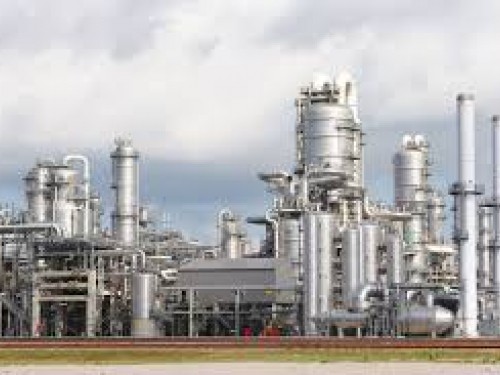
The purpose of the discipline is to provide future masters with theoretical and practical knowledge of the methods of research of chemical and technological processes and systems, namely knowledge of the methods of mathematical planning of the experiment, methods of simulation of chemical and technological processes at various scale levels of chemical and technological systems, the bases of system analysis in chemical technology , calculation, analysis, synthesis, optimization and management of processes of chemical and technological systems. To achieve this goal the student must be aware of the general requirements of the experiment, mathematical modeling and systems analysis as research methods in chemical engineering; to master the methods of mathematical planning of the experiment and its application for optimization of chemical and technological processes; to get acquainted with statistical and deterministic models of CTP; to understand the methodology of mathematical description of chemical reactions and chemical and technological processes; to master the laws of mass and heat exchange processes; learn to use the methods of system analysis for calculations, analysis and synthesis of chemical and technological systems; get acquainted with the algorithms of management of the CTS; to master the concept of the chemical-technological complex, its life cycle, strategy and principles of its research.
As a result of studying the discipline the student must know: the structure, composition and components of modern chemical production; methods of mathematical planning of an experiment in chemical technology; concept of statistical models of chemical-technological processes and their use for solving optimization problems in chemical production; methodology of mathematical modeling in chemical technology; principles of construction of deterministic models of CTP; general models and general laws of mass and heat exchange processes; methodology of mathematical description of chemical reactions; algorithms for solving the main task of chemical and technological calculations; the bases of system analysis in chemical technology as a method of research of CTP and CTS; methodology of calculations, analysis and synthesis of chemical and technological systems; topological models of CTS and topological method of their analysis; algorithms for controlling the CTS.
According to the Law of Ukraine “On the quality and safety of food products and food raw materials,” a biologically active additive – a substance or mixture thereof used to provide a diet of special medical or therapeutic and prophylactic properties. Biologically active supplements contain one or more of the following ingredients:
- Vitamins;
- Minerals;
- Medicinal plants;
- Amino acids;
- Other substances that are intended to supplement food by increasing the intake of nutrients;
- Concentrates, metabolites (carbohydrates, lipids, proteins, nucleic acids), extracts or their combinations.
The main purpose of creating dietary supplements is the ability to adjust the chemical composition of dietary rations with the help of concentrates of micro-and macronutrients and thereby give them a certain biological orientation. BADs are made in the form of pharmaceutical forms – powders, tablets, capsules, extracts, infusions, and the like from raw vegetable, animal or mineral origin, and from substances that are obtained by chemical and biotechnological methods.
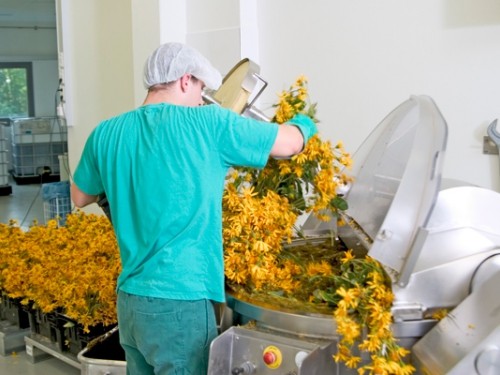
Biologically active food supplements are divided into 3 main groups: intramuscular, parapharmaceutical, eubiotics.
Nutritionists are dietary supplements that are essential biological active substances and are the main components of the body: vitamins, macro- and trace elements (iron, calcium, selenium, zinc, fluoride, etc.), polyunsaturated fatty acids, essential amino acids, some mono- and disaccharides, food fibers. The purpose of using nutritic drugs is to correct the chemical composition of human food. They can contain daily doses of a complex of essential substances. It is an intermediate product between food and medicines – it saturates the body with nutrients, but it is not possible to replace them with food. Nutritionists can adjust the diet and improve the body, but you can not cure a person.
Parapharmaceuticals are dietary supplements that exhibit certain pharmacological activity and are used for prophylaxis, auxiliary therapy and maintenance in the physiological limits of the functional activity of organs and systems. These include: bioflavonoids; alkaloids; glycosides; saponins; organic acids; essential oils; polysaccharide
Ebiotics (probiotics) are dietary supplements that include living microorganisms and / or their metabolites (bifidobacteria, lactobacillus) that exhibit a normalizing effect on the composition and biological activity of the microflora of the digestive canal.
The purpose of the discipline “Chemical and physico-chemical methods of analysis of food additives and cosmetics” is the acquisition of knowledge about the classification and chemical properties of nutritional supplements and cosmetics; chemical and physico-chemical methods of their qualitative detection and quantification; metrological bases of analytical control; to reveal the connection of food additives and cosmetics with the goals of human health; Teach students to apply acquired knowledge to solve practical problems in food production and cosmetology.
As a result of studying the discipline the student must know the classification and chemical properties of food supplements and cosmetics; theoretical foundations and practical use of methods of qualitative, quantitative and analytical analysis for identification and determination of the content of nutritional supplements and components of cosmetic products; the connection of dietary supplements and cosmetics with the objectives of human health.
Intellectual property is the result of intellectual creative activity of one person (author, performer, inventor, etc.) or several persons. For the first time, this term was used in 1845 by Charles Woodbury, a judge of the District Court of Massachusetts. In Europe, for the first time, this term was used by Alfred Nion in his treatise “Civil Rights of Authors, Artists and Inventors”, which was first published in 1846. The actual history of the term began in 1967, after the creation of the World Intellectual Property Organization and. She made a lot of effort for world recognition to fix the term, which is a key part of her name.
In Art. 41 of the Constitution of Ukraine provides that everyone has the right to own, use and dispose of the results of his intellectual (creative) activity. However, not every result of creative activity becomes an object of intellectual property. The object of intellectual property is recognized only as a result of creative activity, which corresponds to the established requirements of the law. State registration of copyright in Ukraine is carried out in accordance with the Law of Ukraine “On Copyright and Related Rights” of December 23, 1993 No. 3792-12 and the Resolution of the Cabinet of Ministers of Ukraine dated December 27, 2001 No. 1756 “On the State Registration of Copyright and Contracts , concerning the author’s right to work “.
Scientific and technological achievements can be recognized as objects of industrial property only after their qualification as such an appropriate state body, state registration and issuance of a security document. The state qualification is carried out by the State Enterprise “Ukrainian Institute of Industrial Property”, which is a part of the State Service of Intellectual Property, on the basis of special examinations – formal and qualification.
For the registration of the rights to inventions, utility models and industrial designs, it is necessary to submit an appropriately executed application to the State Service of Intellectual Property. For this purpose, the application is sent to the address of the State Enterprise “Ukrainian Institute of Industrial Property”, a subordinate institution, where the examination takes place. At the same time as the publication of information about the issuance of a patent, the Institution carries out the state registration of the patent, which makes the relevant data in the register. The Patent is granted by the Office within one month after registration of the patent. The author has the right to submit an application. In the cases established by law, this right is the employer.
Before the decision of the Patent Office or the refusal to grant a patent, the applicant has the right, on his own initiative, to make corrections and clarifications to the application. If the specified corrections and clarifications are submitted to the Office after the decision on granting a patent or refusal to issue it, they are no longer taken into account in accordance with the Law. However, these corrections and clarifications are taken into account if they arrived after the publication of the information about the patent application for the industrial property object, but six months before the date of publication. After receipt of the document for payment of the fee for submitting an application to the Office, she undergoes a formal examination (formal examination). The purpose of this expert examination is to identify two important factors: (i) whether the proposed offer to the objects of industrial property belongs; (ii) whether the submitted application materials comply with the requirements of the law.
Formal examination must be carried out within six months from the established date of filing the application. According to the results of the formal examination, the Institution is obliged to inform the applicant about the completion of the formal examination or the requirement to make the necessary changes to the application materials. If according to the results of the formal examination it turns out that the declared proposal does not belong to the objects of industrial property or it concerns those objects that can not be recognized as industrial property, the Institution shall inform the applicant of the refusal to publish the patent. The said refusal shall be made by a special decision of the Office. As a result of formal examination, the majority of cases is that the application meets the established requirements, and the document for payment of the fee for filing an application is also available. The institution shall inform the applicant of the completion of the formal examination. This means that the next stage of consideration of the application may be the conduct of a qualification examination (examination on the merits) of the application. However, the law grants the applicant the right to request the grant of a patent application for invention. If the application complies with the requirements of the Law and the document for payment of the fee for filing the application, the Institution conducts an examination on local novelty. Expertise on local novelty is an integral part of the qualification examination, which has the purpose of identifying only local novelty. The local novelty is the one that is established on the basis of patents for inventions issued in Ukraine and applications filed to the Patent Office filed with the Office. Thus, in Ukraine there are two types of patents for invention: a 20-year patent issued after an examination on the merits, and a declarative patent – a kind of patent issued on the basis of formal examination and examination of the local originality of the application for an invention. The validity period of the patent is taken from the date of submission of the application to the Office. If the application was initially filed in one of the countries of the Paris Union, and then in Ukraine, then the patent is deducted from the date of the previously filed application, which is called a convention priority.
Studying the subject “Intellectual Property” students are acquainted with the system of intellectual property, inventive and patent-licensing activities, the laws of Ukraine on the protection of intellectual property and the legal regulation of relations, which are formed in connection with the creation, protection and use of the results of creative activity, studying use sources of patent and technical literature, get acquainted with the rules for filing applications for invention and other documents related to intellectual property . According to the requirements of the educational-professional program students must know: definition of objects of intellectual property, subjects and objects of intellectual property rights; history of intellectual property rights; the place and role of intellectual property in the economic and social development of society; main ways of protecting intellectual property rights; the system of international cooperation in the field of intellectual property.
Scientific research – the process of studying a particular subject or phenomenon with the help of scientific methods, which aims to establish the laws of its origin, development and transformation in the interests of rational use in the practical activities of people.
The notion of “science” has several basic meanings. First, under the science (Greek episteme, lat. Scientia) we understand the sphere of human activity, which is aimed at the development and theoretical schematization of objective knowledge of reality. In the second sense, science acts as a result of this activity – the system of scientific knowledge gained. Thirdly, the term “science” is used to refer to individual branches of scientific knowledge. Fourthly, science can be regarded as a branch of culture that existed not at all times and not in all peoples. During the historical development of science has become a productive power of society and the most important social institution.
Science differs by subject and object of research. The subject of science is the party in which the object is represented in science. The object of research is a side of reality, the study of which is aimed at this science. Each science is characterized by its concepts, means and methods.
The basis of science is the laws – open steel ties between phenomena. The set of laws is a theory – a systematic description and explanation of phenomena in a particular area. The development of science is the development and change of theories. The theory exists until the facts that contradict its provisions accumulate. The inability to explain new facts within the existing theory generates the need for analysis and development of a new set of hypotheses.
The form of existence and development of science is a scientific research. The purpose of scientific research – the definition of a specific object and a comprehensive, reliable study of its structure, characteristics, relationships on the basis of the principles and methods of cognition developed in science, as well as the obtaining of results useful for human activity, introduction into production with the subsequent effect. Result of scientific studies are valued the higher, the higher the scientific quality of the conclusions and generalizations made, the more reliable and effective they are. They should create the basis for new scientific developments. One of the most important requirements for scientific research is a scientific generalization, which will allow establishing the relationship and relationship between the phenomena and processes under study and make scientific conclusions. The deeper conclusions, the higher the scientific level of research.
Scientific (research) activity – an activity aimed at obtaining and applying new knowledge, including:
- fundamental research (experimental or theoretical activity, aimed at obtaining new knowledge about the basic laws of the construction, functioning and development of man, society, environment);
- Applied research (research aimed primarily at applying new knowledge to achieve practical goals and solving specific problems).
The purpose of teaching the discipline “Basics of the scientific research” is to disclose the content, structure of the discipline, the formation of scientific potential and research skills of engineer technologists, providing the necessary basis for active participation in innovative practice.
According to the requirements of the educational-professional program, students must know: the methodology of conducting research, methods of substantiation of topics of scientific research; stages of scientific research; main organizations of scientific and technical information, modern sources of scientific information on chemical technology of food supplements and cosmetics, classes UDC (chemistry); basics of patent science, licensing; classification of measurements, principles of arrangement and operation of main measuring devices, circuits and research facilities, measurement errors; bases of experimental technique, methods of purification of solutions, gases, metals from impurities; methods of mathematical planning of an experiment and processing of scientific results, estimation of experimental errors; ways of designing the results of scientific research.
FOOD ADDITIVES AND COSMETICS PRODUCTION
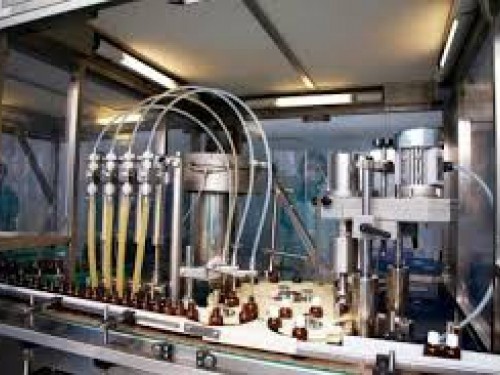 The production of nutritional supplements is faster than food. It is associated with the general trends in the development of a healthy eating industry: the production of low-calorie products, with a low content of sugar and fat, dietary and therapeutic purposes, and rapid cooking is growing. All these products should be characterized by the same positive qualities as traditional ones. The use of nutritional supplements is relevant and in order to increase the competitiveness of products. It should significantly improve the appearance, taste, aroma, consistency of products, ensure the release of products with a given set of poly-functional properties, increased resistance to storage. It is very important that the supplements made do not change the nutritional properties of the food.
The production of nutritional supplements is faster than food. It is associated with the general trends in the development of a healthy eating industry: the production of low-calorie products, with a low content of sugar and fat, dietary and therapeutic purposes, and rapid cooking is growing. All these products should be characterized by the same positive qualities as traditional ones. The use of nutritional supplements is relevant and in order to increase the competitiveness of products. It should significantly improve the appearance, taste, aroma, consistency of products, ensure the release of products with a given set of poly-functional properties, increased resistance to storage. It is very important that the supplements made do not change the nutritional properties of the food.
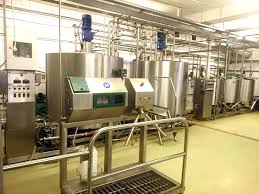 Production of cosmetics also develops at a great pace. The volume of cosmetic market of Ukraine is on average UAH 21 billion annually. In 2015, the dynamics was 4%. In the last two years, inflation has been at a minimum level in the country, therefore the market has increased due to organic growth – growth in sales in kind.
Production of cosmetics also develops at a great pace. The volume of cosmetic market of Ukraine is on average UAH 21 billion annually. In 2015, the dynamics was 4%. In the last two years, inflation has been at a minimum level in the country, therefore the market has increased due to organic growth – growth in sales in kind.
If you look at the structure of the world cosmetics market, then it is significantly different from the Ukrainian one. If the share of skin care products is 24% in the world, then in Ukraine – 17%. This is primarily due to the fact that the Ukrainian market is still developing, and the culture of skin care is inherent in a more mature market. At the same time, for example, the category of “hand cream” in Ukraine accounts for 11% of the market for skin care, and in the world only 3%. A large proportion of this category is due to cold winters and a small number of dishwashers. Another important difference is that 10% of sales on perfumery in the world market, 12% in Ukraine. Here you should take into account the lipstick effect. So called the feature of demand, indicated in the United States a few decades ago: when due to the crisis phenomena in the country’s economy people fell purchasing power. It would seem that cosmetics should save, but lipstick sales showed steady growth.
The subject of studying the discipline “Production of dietary supplements and cosmetics” includes information on the classification of food additives, food and cosmetics, and the basic laws of food and cosmetic technologies, the theoretical basis of food technology processes, and the hygienic regulation of nutritional supplements in food.
The practical orientation of the discipline is determined by the teaching of the general provisions of the technology of modern cosmetic products on the basis of informative materials of the most modern domestic and foreign productions. The discipline will allow future specialists to master the basic issues of the development of cosmetic products of various composition and direction of action, control of cosmetic products, to carry out work related to the receipt of various cosmetic products and to carry out their manufacture at laboratory classes, will enable to improve the existing technologies of making cosmetic forms by influencing the main technological stages and techniques, focuses on reducing the cost of material resources and energy costs associated with production.
The purpose of teaching the discipline “Production of dietary supplements and cosmetics” is the disclosure of the content, the structure of the discipline, the formation of scientific potential and research skills of engineers – technologists, providing the necessary basis for active participation in innovative practice.
According to the requirements of the educational-professional program students must know: general information about nutritional supplements; the classification of dietary supplements depending on their purpose; complex food supplements; a general approach to the selection of dietary supplements; hygienic regulation of food additives in food; a consistent assessment of the toxic safety of nutritional supplements; food production as a chemical-technological system; technological schemes of production of food additives of different functional classes; main forms of organization and types of cosmetic productions; the main components of the technological regulation of cosmetic production; characteristics and types of technological plants for cosmetic production; the main ways of ensuring the quality of cosmetic products; the state of the modern market of food supplements and cosmetic products and the basic marketing strategies of production; common problems of food industry and food additives technologies; ways to increase the competitiveness of food additives, food and cosmetics: the main areas of technological and prescription innovations used in production.
Technology is the science of the most economical ways and processes for the production of industrial products from natural raw materials. The method of production is a set of all operations that pass the raw material before receiving a product from it. The method of production consists of the successive operations occurring in the corresponding machines and machines. Such a sequence of operations is a chemical and technological process of processing of raw materials. The basis of the CTP stage: the preparation of raw materials, its chemical or more often physical and chemical processing and the allocation of finished chemical products. From the perfection of each of these operations depends on both technological and technical and economic indicators of production. Without diminishing the importance of the stages of preparation of raw materials and processing of finished products, we note that from the standpoint of studying the basics of chemical technology, the most important is the process of actually physicochemical processing of raw material into the product of production.
When studying the discipline, students get acquainted with food additives as production objects, with the classifications and characteristics of technological processes and production, with the main kinetic and technological patterns of food technologies and technologies of food additives, methods of processing raw materials and their influence on the chemical composition and properties of finished products.
Purpose of the discipline: to show the organic connection of the technology of nutritional supplements with the general food technology and the purpose of the food additives in the manufacture of food products. Students get new knowledge about raw materials and assortment of food products and food additives, the classification of food industries, physicochemical patterns of food technology, the essence of individual chemical processes and their role in the production of food additives, the basic methods of processing raw materials in the technologies of food additives, mass exchange and chemical processes.
As part of the educational program “Chemical Technology of Nutrition Supplements and Cosmetic Products”, the teaching of discipline on new chemical systems and technologies aims to provide future nutrition supplements and cosmetics specialists with knowledge and skills in developing new formulations of complex nutritional supplements.
Complex dietary supplements are industrial mixtures of food additives of the same or different technological purposes, which may include but not limited to dietary supplements, biologically active additives and certain types of food raw materials: flour, sugar, starch, protein, spices, etc. They are complex supplements. Particularly widespread complex food supplements have been obtained in baking technology, in the production of flour confectionery, meat industry. Sometimes this group also includes auxiliary materials of a technological nature.
The development of products with new nutritional properties through the use of complex nutritional supplements is one of the areas of innovation in the development of food technologies. For example, in recent years in the baking industry, complex improvers have been used that contain, in optimal proportions, several additives of different nature and principle of action. They contain various enzyme preparations, oxidizing agents, reducing agents, hydrocolloids, surfactants, organic acids, mineral salts and the like. The use of such complex enhancers can simultaneously influence the main components of the flour, increase the efficiency of each component of the enhancer due to the synergy of their action, and thus reduce the cost and simplify the methods of their use. The main directions of developments in the meat industry are related to the “design” of multicomponent mixtures – the so-called synergistic mixtures of hydrocolloids and stabilization systems.
Tasks of discipline: mastering of theoretical and practical bases of chemistry of different classes of nutritional supplements by students; formation of knowledge, allowing to understand the principles of chemical, biochemical and technological processes of processing and storage of food raw materials and finished products; development of practical experience in the use of chemical knowledge in professional activities.
The purpose of teaching discipline is to prepare engineer technologists for production and technological activities, which involves knowledge of the current state, perspectives and main directions of development of the chemical and cosmetic industry; formation of theoretical and practical knowledge of the basic principles of the organization and technological design of the enterprises of the industry.
Students learn to develop the master plan of the enterprise, master the principles of zoning the territory of the enterprise and the characteristics of the main, auxiliary, service and administrative production premises, know the methods of layout of technological equipment, plans and sections of buildings. The main tasks of studying the discipline “Technology, equipment and design of chemical and cosmetic industries” is the mastery of knowledge about modern methods of designing productions. According to the requirements of the educational-professional program students must know: the main problems of scientific and technological development of the chemical and cosmetic industry, tasks and directions in the design of production; principles of construction of the general and situational plan of the enterprise; principles of zone zoning of the enterprise; concept of production capacity and its relation with the enterprise being projected; connection of load-lifting mechanisms and construction parts; classification and structural elements of industrial structures; general information about building plans; stages of development of a three-dimensional planning production decision; characteristics of the premises included in the production; methods and principles of the layout of the main and auxiliary equipment of production.
The development of the world chemical industry in recent years is determined mainly by such important influential aspects:
- the steady increase in the role of chemical science and industry in the field of material production, which is associated with growing volumes of production, the continuous expansion of the range of products, the creation of new types of substances and materials, increased requirements for the quality and purity of products;
- persistent tendencies of rising prices for energy, material and other natural resources that are necessary for different production processes;
- the rigidity of competition in the market of goods of the chemical industry.
In these difficult conditions, the primary condition for the successful operation of an industrial enterprise can only be the formulation and solution of the task of reducing the cost (production cost) of manufactured products. This requires implementation of a complex of measures, the most important of which are: the use of sufficiently precise methods of calculations of chemical and technological processes, as well as the selection of optimal (the best in a certain sense) modes of their functioning.
Traditional methods of calculating chemical and technological processes based on the use of simplified mechanisms of their flow and therefore require the introduction of significant stock ratios, are in most cases approximate and do not meet modern requirements at all. Exact results can sometimes be obtained as a result of rather complex and cumbersome calculations, but much more often they can not be obtained without the use of modern computer technology and specialized software packages. Only computer simulation as a tool for calculating chemical and technological processes gives the opportunity to take into account the greatest number of factors and phenomena that influence the course of real processes, and to ensure a high accuracy of prediction of their behavior in various conditions. As a result, the stock ratios can be minimized, which is one of the essential factors in saving material, energy or other resources.
To determine the optimal mode of technological process in chemical technology, an experiment is traditionally used on existing equipment. If it is impossible to conduct experiments, it remains to rely on the experience gained during the operation of technology operators. Often, for these purposes, laboratory (similar, similar, but cheaper) installations or technological lines are created, with the further realization of a complex of experiments on them. However, this approach has disadvantages, which are costly in terms of resources and time, and sometimes dangerous. Accurate calculations of the optimal flow of the technological process on the basis of mathematical models and the possibility of their operational adjustment is another important factor in increasing the efficiency of production.
As we see, for solving the above tasks we need reliable and reliable mathematical models of chemical-technological processes and wide application of mathematical modeling. The essence of this methodology is to replace the original object with its “image” -the mathematical model – and in the future in the study of the model with the help of computational-logical algorithms implemented on computers. This method of knowledge combines the benefits of both theory and experiment. The work is not with the object itself (phenomenon, process), but with its model makes it possible to study its properties and behavior in any permissible situations (the advantages of the theory) without any pain, relatively fast and without significant expenses. At the same time, computational (computer, simulation) experiments with object models allow, based on the efficiency of modern computing methods and technical tools of computer science, to study in depth and deeply objects in an extent not accessible to theoretical approaches (advantages of the experiment). All this is the reason that the methodology of mathematical modeling is developing rapidly, covering all new spheres – from the development of technical systems and algorithms for managing them to the analysis of the most complex economic and social processes.
Elements of mathematical modeling have been used since the very beginning of the emergence of exact sciences, and it is no coincidence that some methods of calculations are called the names of such leaders of science as Newton and Euler, and the word “algorithm” comes from the name of the medieval Arab scientist Al-Khorezm. The second “birth” of this methodology came at the end of the 40’s – the beginning of the 50’s of the XX century and was conditioned, at least, for two reasons. The first of them – the emergence of computers (computers), which deprived scientists of a huge amount of routine computing work. The second is the implementation of national programs of the USSR and the US for the creation of a missile nuclear shield, which could not be realized by traditional methods. Mathematical modeling also fulfilled this task: nuclear explosions and flights of missiles and satellites were pre-executed by computers using mathematical models and only then transformed into practice. This success has largely determined the further development of the methodology of mathematical modeling, without which nowadays in developed countries, no large-scale technological, environmental or economic project is seriously neglected.
Technical, ecological, economic and other systems that are studied by modern science, are often not subject to research (in the right completeness and accuracy) by conventional methods. A direct field experiment on them is long, expensive, often dangerous or, as a rule, impossible, since many of these systems exist in a “single copy”. The price of errors and mistakes in dealing with them is unacceptably high. Therefore, mathematical (wider – informational) modeling becomes an inevitable component of scientific and technological progress.
The pursuit of the implementation of such complex tasks in the chemical industry has led to an intensive accumulation of knowledge at the junction of two sciences – cybernetics and science of chemical technology. In connection with the necessity of setting and solving problems of chemical technology with the use of methods and tools of cybernetics in recent years, a new scientific direction, known as chemical cybernetics, arose.
Considering the broader issue, one can note that the elements of modeling are available in almost all kinds of creative activities of people of various “specialties” – researchers and entrepreneurs, politicians and military leaders. The introduction of precise knowledge into these areas helps to limit intuitive speculative “modeling”, expands the field of application of rational methods. Of course, mathematical modeling is effective only when fulfilling certain professional requirements: clear formulation of the basic concepts and assumptions, analysis of the adequacy of the models used, guaranteed accuracy of computational algorithms, etc. If we talk about modeling systems with the participation of the “human factor”, that is, objects that are heavily formalized, then these requirements need to add the need for a precise delimitation of mathematical and life terms (such that they sound the same but have different content), cautious use already existing mathematical apparatus to study the phenomena and processes studied (the best way “from task to method”, and not vice versa), and much more.
Thus, on the basis of the foregoing, one can conclude that a specialist in the construction of models and modeling must have a clear idea of the nature of the physical and chemical phenomena occurring in the object and be able to mathematically describe the processes occurring in the object, that is, to apply modeling methods.
Computer technology or information technology is a generic term for storing, transmitting, processing, protecting, and reproducing information using computers. It is impossible to imagine modern production and modern science wherever computers would not be used. Computing technology is increasingly used not only for automation of production, but also in its various fields. Such involvement of computing and microelectronic technology in the activities of various production systems is called computerization of production.
Computerization is the basis of technical re-equipment of production, a condition for improving its efficiency is required. On the basis of computers and microprocessors, technological complexes, machines and equipment, measuring, regulating and information systems are being created, design and development works and research are carried out, informational services, training and more are carried out, which provides for the improvement of social and individual productivity of labor, creation of conditions for comprehensive and harmonious development of personality.
The discipline “Computer technologies in science and engineering in nutritional supplements and cosmetics” is intended to activate the use by students of the PC in the educational process and, in particular, in the implementation of course and diploma projects, to deepen the knowledge and skills of students in programming in Excel, MathCad environments and Visual Basic for Applications. The necessity of developing new algorithms will facilitate more qualitative assimilation by students of the technological aspects of disciplines of specialization. In studying this discipline, students receive specific professional knowledge and skills from the methodology of constructing an algorithm for calculating a specific process or object and implementing an algorithm in the indicated environments.
FOOD PRODUCTION TECHNOLOGIES
The purpose of teaching the discipline “Food production technologies” is to provide future masters with information on the theory and practice of food production, on the basic laws of food technology, and hygienic regulations on the use of food supplements in food. The main tasks of the study of the discipline “Food production technologies” are mastering the knowledge about the principles of organization of food technologies and their use in the production of basic food products, the rules and rules for the use of food additives in food products, familiarity with the objects and tasks of the future specialty. Studying discipline provides the necessary basis for undergraduate practice, as well as for further self-improvement through self-training.
While studying the discipline the student must know:
- Features of technology of food production;
- Classification of industries in the food industry;
- Main components of raw materials and their role in various technological processes;
- Principles of rational use of raw materials, energy resources, equipment;
- General characteristics of food production;
- Scientific and theoretical foundations of separate technologies of food production (flour, bread, bakery products, macaroni products, products of oil and fat production, sugar, milk and dairy products, meat products);
- The state of the modern food market and the main marketing strategies of production;
- General issues of food industry and food additives technologies;
- Ways of increasing the competitiveness of food products and the main directions of technological and prescription innovations that are used in production.
